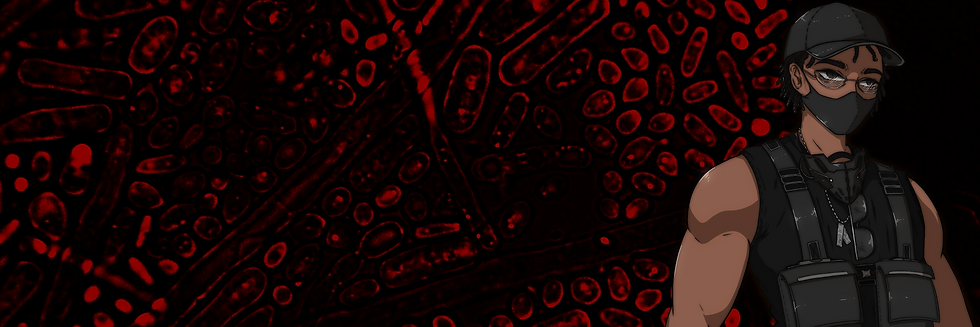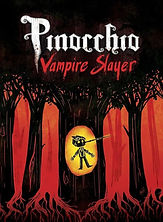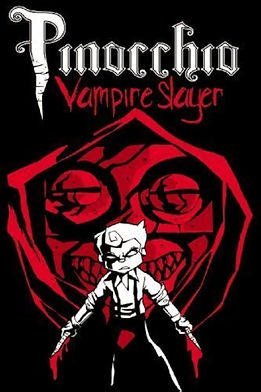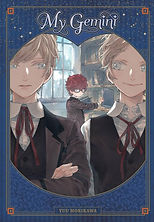
JOSHUA D. MARTIN
『 REDPLICANT 』
【 AUTHOR | LYRICIST | SCREENWRITER | BLOGGER 】
PINOCCHIO: VAMPIRE SLAYER

ACTION-HORROR | FANTASY

Courtesy Top Shelf Productions
Pinocchio: Vampire Slayer is an action-horror and fantasy-adventure comic trilogy (also available in one convenient graphic novel). As you may recognize in the title, it takes inspiration from the age-old children’s story, Pinocchio. However, instead of being a retelling, Van Jensen and Dustin Higgins make every event in Pinocchio’s original lore canon– his origin story, if you will. Later in the series, they add more elements to the Wooden Puppet’s mythology, which expands the universe far beyond what we would’ve read in the original books by Carlo Collodi.
This Pinocchio variant is still a wooden boy. His creator and father, Geppetto, was ruthlessly slaughtered by vampires. The classic garlic-allergic, sun-intolerant, God-cursing, wooden stake-hating vampires. It sounds like an idea that shouldn’t work, but it reads like it was always meant to be. Van and Dustin carefully craft a vivid visceral, horrific, and comedic experience. Pinocchio is on a rampage, sworn to kill any vampire, no matter how good they seem. He tells a lie– usually a wisecrack joke –and snaps off his nose to use as a wooden stake. He’s an exceptional vampire killer, and even though everyone may not believe his stories of blood-sucking monsters, he continues to clean the streets of devil-spawn scum.
Pinocchio is not the first children’s story to be adapted into horror for a young adult audience. Let alone the first children’s story to be adapted into horror for a young adult audience with a vampire twist. And yet, Pinocchio: Vampire Slayer is strikingly original in its execution. It’s full of heart, clever one-liners, and sick metal-fantasy-style writing. Van and Dustin masterfully balance the times when the narrative takes itself seriously and pokes fun at itself without getting tiresome.
The art is scratchy, dark, and offbeat. It’s almost twisted and out of place, like a high schooler doodling in their notebook, but it’s somehow still fluid and fully visualized. The talent shines through to take these uneasy, sketchy designs and make them feel alive, like they’re full of blood, sweat, and tears. That wasn’t the most flattering way to describe the art style, but it lends very well to the tone and themes of the book.
Pinocchio is still a young wooden boy who’s impulsive and prone to make mistakes. Throughout the book/series, he grows in more ways than his trifling nose. He still holds all of the character development from Carlo’s stories with Van and Dustin’s added guilt, trauma, and angsty resentment. I mean, it’s all understandable. Vampires killed his dad.
For fans of Lincoln: Vampire Slayer, Blade, Castlevania, Evil Dead, and the pulp fiction genre, this is a gnarly read for you. Put on some gothic lo-fi or post-rock music in the background and burn through this awesome piece in one night. You won’t regret it, and my nose ain’t growing.
MY GEMINI

Light Academia | Cozy Mystery
Courtesy of Yen Press
I came across My Gemini at Momocon in Atlanta. The cozy cover instantly beckoned to me. And it was the only copy– I knew I had to buy it. Without knowing much about the story or the author, the book presented itself in such a way that I had no doubts it’d be a delightful read. I also Googled the name and discovered it was a one-shot manga by the author and artist Yuu Morikawa. Even better, there was no commitment.
The synopsis is simple. My Gemini is a retelling of Jekyll and Hyde. Jekyll is calm and collected while Hyde is loud and playful. They like switching places to fool with people, but only one other person can tell them apart, their dear friend, John Utterson. Unfortunately, one of the twins passes away in an accident. So that leaves us with the looming question, are they Jekyll or Hyde?
It had been a while since I read manga, though. So, like an idiot, I opened the book on the last page and saw these damning words, “Hello, [REDACTED],” said John. It was over. I knew who the twin was! How could I read this manga when all of the mystery was erased due to my ignorance? Well, I was glad I read it anyway (I did spend money on it after all). Because just like how you don’t really know other people as much as you think you do, I had no idea what this book was about. Getting to learn this book was a journey worth taking and I was humbly reminded what reading stories was for.
At first, it seemed obvious who the living twin was. For a story with so few components, Yuu does a fantastic job adding depth to Jekyll and Hyde’s relationship. It’s so refreshingly simple yet rich and meaningful. This game the brothers play is their ritual that keeps them together and in sync. Jekyll gets to be Hyde and experiences loving attention from friends and family, and Hyde becomes Jekyll to be with his brother. All was going great until John pointed them out by accident. But to the Stevenson brothers, it only got better. Now, they could improve their game to avoid detection from others.
One of the twins watched his brother lay beneath the dirt. It took a piece of him away. Throughout the story, John investigates the last messages one of the brothers left behind in letters, notebooks, and doctor’s records. John questions if he knew the Stevenson brothers as well as he thought he did, and so did I. Ah, I felt relieved that I was beginning the question the ending I saw as I didn’t know how true it was.
Yuu Morikawa’s artwork captures the academic setting in a cozy atmosphere. The highly detailed, hand-drawn scenery and cinematic panels make it a smooth reading experience. Your eyes will glide from page to page. The character designs are excellently realized and have a dream-like quality to them. They have a tone that romanticizes youth and the “coming-of-age” stage of life.
What do we miss when someone we love passes away? Is it their soul, how we remember them, or their “likeness” expressed by others who’ve interacted with them? Take the Ship of Theseus for example. Sure, you have the ship itself, the crew of the ship, but also the ship’s paint job, name, and culture– its identity and branding. You could paint another ship the same colors, bestow the same name, and sail under the same captain, but could you still tell the difference? Does changing the ship’s name and appearance influence its parts and crew?
Bloated analogy aside, to John, his friend never seemed dead. From the letters he left to the remnants he saw in the living brother, it looked like their ghost was walking with them. I think this manga asks the question “Are we attached to people as who they are or the likeness they portray?” If you couldn’t tell your loved one was standing right in front of you, even though they were pretending to be someone else, did you know and love them at all? This was John’s dilemma, trying to close the gap between him and a friend that their brother left in his absence.
My Gemini is a wonderful, heartwarming book for fans of Violet Evergarden, slice of life, and mystery with low steaks. If you’re going in expecting a murder mystery or a psychological thrill, you’ll be disappointed. But even for fans of spooky tales, there’s a soft eerieness to be appreciated in Morikawa’s authorial voice.